 |
| c1836 Portrait of Clarkson Stanfield, R.A. by John Partridge oil on card 25.7 x 20 cm Royal Academy of Arts, London |
Clarkson Frederick Stanfield RA RBA (1793 – 1867) was a prominent English painter who was best known for his large-scale paintings of dramatic marine subjects and landscapes. He was the father of the painter George Clarkson Stanfield and the composer Francis Stanfield. He was born in Sunderland, the son of James Field Stanfield (1749–1824) an Irish-born author, actor and former seaman, and Mary Hoad, an artist and actress. Stanfield was named after Thomas Clarkson, the slave trade abolitionist, whom his father knew, and this was the only forename he used, although there is reason to believe Frederick was a second one.
He was briefly apprenticed to a coach decorator in 1806, but left owing to the drunkenness of his master's wife and joined a South Shields collier to become a sailor. In 1808 he was pressed into the Royal Navy, serving in the guard-ship HMS Namur at Sheerness. Discharged on health grounds in 1814, he then made a voyage to China in 1815 on the East Indiaman “Warley” and returned with many sketches.
An accident forced Stanfield to leave active service, but during his voyages he had acquired considerable skill as a draughtsman. In August 1816 Stanfield was engaged as a decorator and scene-painter at the Royalty Theatre in Wellclose Square, London. Along with David Roberts he was afterwards employed at the Coburg theatre, Lambeth, and in 1823 he became a resident scene-painter at the Theatre Royal, Drury Lane, where he rose rapidly to fame through the huge quantity of spectacular scenery and (moving) dioramas which he produced for that house until 1834.
Stanfield abandoned scenery painting after Christmas 1834, though he made exceptions for two personal friends: he designed scenery for the stage productions of William Charles Macready, and for the amateur theatricals of Charles Dickens.
Stanfield developed his skills as an easel painter, especially of marine subjects; he first exhibited at the Royal Academy in 1820 and continued, with only a few early interruptions, to his death. He was also a founder member of the Society of British Artists (from 1824) and its president for 1829, and exhibited there and at the British Institution, where in 1828 his picture “Wreckers off Fort Rouge” gained a premium of 50 guineas.
 |
| Wreckers off Fort Rouge oil on canvas 174 x 246 cm |
He was elected Associate Member of the Royal Academy in 1832, and became a full Academician in February 1835. His elevation was in part a result of the interest of William IV who, having admired his St. Michael's Mount at the Academy in 1831 (now in the National Gallery of Victoria, Australia), commissioned two works from him of the “Opening of New London Bridge” (1832) and “The Entrance to Portsmouth Harbour.” Both remain in the Royal Collection. Until his death he contributed a long series of powerful and highly popular works to the Academy, both of marine subjects and landscapes from his travels at home and in France, the Netherlands, Germany, Italy, Spain, and Ireland.
He also executed two notable series of Venetian subjects, one for the former dining room at Bowood House, Wiltshire, for the 3rd Marquess of Lansdowne, the other for the Duchess of Sutherland at Trentham Park, Staffordshire. Neither house survives but some of Stanfield's work for Bowood can still be seen there (the present Bowood House and park, open to the public, is a conversion of the old stable block).
He illustrated Heath's “Picturesque Annuals” for the years 1832–34, and in 1838 published a collection of lithographic views on the Rhine, Moselle and Meuse: the forty subjects from both sides of the English Channel were also steel-engraved under the title of “Stanfield's Coast Scenery” (1836). Among literary works for which he provided illustrations were Captain Marryat's “The Pirate and the Three Cutters” (1836), “Poor Jack” (1840) and the lives and works of Lord Byron, George Crabbe, and Samuel Johnson, mainly in editions by John Murray.
In 1870, three years after his death, Stanfield was awarded a major retrospective of his work at the inaugural Royal Academy Winter Exhibition. In its appraisal of the show, The Times newspaper wrote: "There are no English painters whose works have won wider and warmer popularity outside the artistic pale. Stanfield's practiced command of the artist of composition, his unerring sense of the agreeable and picturesque in subject and effect, his pleasant and cheerful colour and last, not least, the large use to which he turned his knowledge and love of the sea and shipping… (all) added to the widespread admiration he had won by his consummately skillful scene painting, (and) combined to make him one of the most popular, if not the most popular, of landscape painters."
This is part 1 of a 7-part series on the works of Clarkson Frederick Stanfield:
 |
| 1820-46 Fire at Sea watercolour and bodycolour on beige paper 42.5 x 31.5 cm Metropolitan Museum of Art, New York |
 |
| 1820-67 Lake of Thun looking North graphite on paper 12.7 x 21.3 cm Metropolitan Museum of Art, New York |
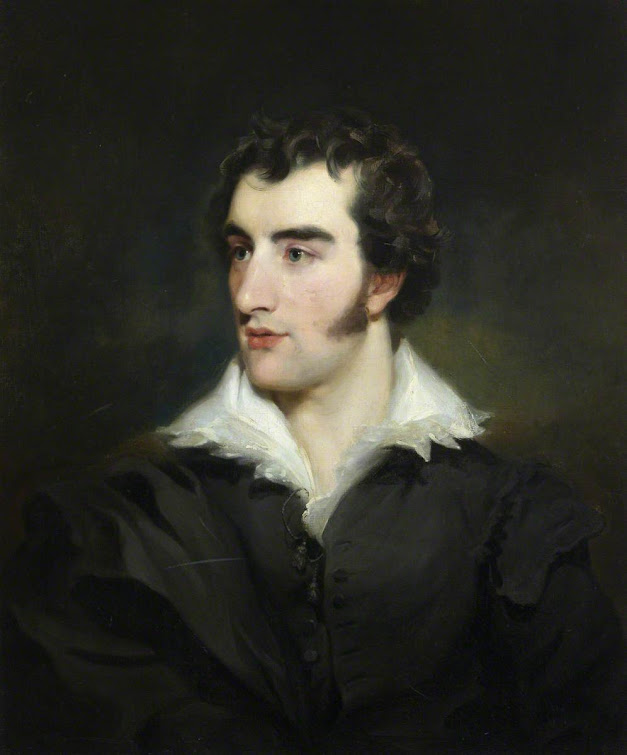 |
| c1820 Robert Liston (1794–1847), FRCSEd oil on canvas 75.1 x 62.3 cm The Royal College of Surgeons of Edinburgh, Scotland |
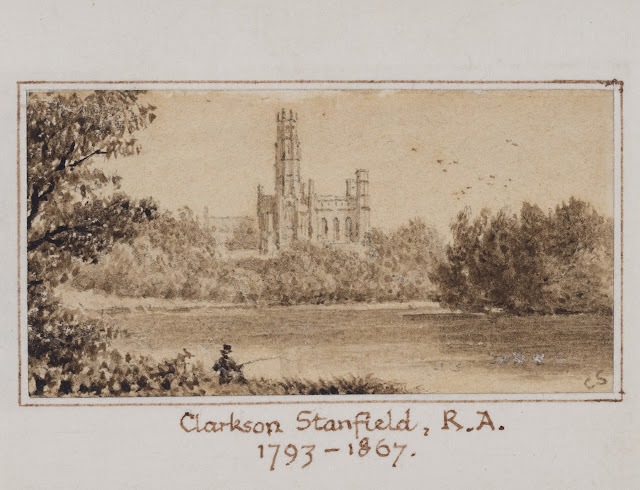 |
| before 1825 Fonthill Abbey watercolour 2.8 x 5.5 cm (sheet) Presented to Queen Mary's Dolls' House in 1922 Royal Collection Trust |
 |
| before1825 Framwellgate Bridge, Durham watercolour 2.8 x 5.4 cm (sheet) Presented to Queen Mary's Dolls' House in 1922 Royal Collection Trust |
 |
| 1825 Lake Como oil on oak panel 47 x 76.8 cm Tate, London |
 |
| 1825-35 Shipping off the Dutch Coast oil on canvas 94.5 x 135.5 cm Science Museum, London |
 |
| 1826 A Market Boat on the Scheldt oil on panel 82.9 x 124.4 cm V&A, London |
 |
| 1826 A Market Boat on the Scheldt detail |
 |
| 1826 Seascape oil on panel 31.4 x 50.8 cm V&A, London |
 |
| 1826 View on the Scheldt oil on panel 40.7 x 54.3 cm V&A, London |
 |
| 1826 View on the Scheldt detail |
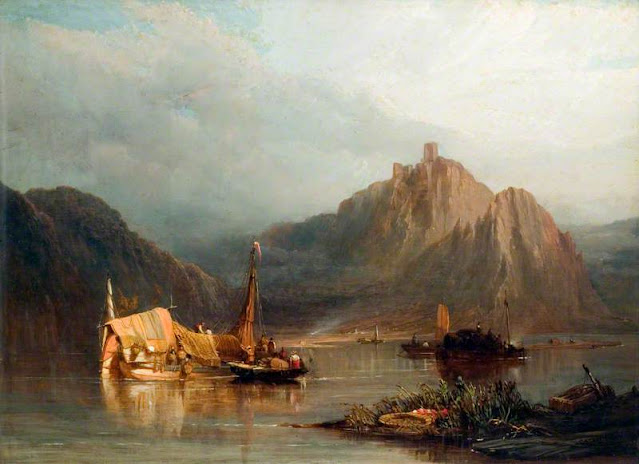 |
| 1827 View on the Rhine oil on panel 41.3 x 55.6 cm V&A, London |
 |
| 1829 A View near Devizes, with Stoke Park, Erlestoke, in the Middle Distance oil on canvas 119.5 x 188 cm National Trust, Tatton Park, UK |
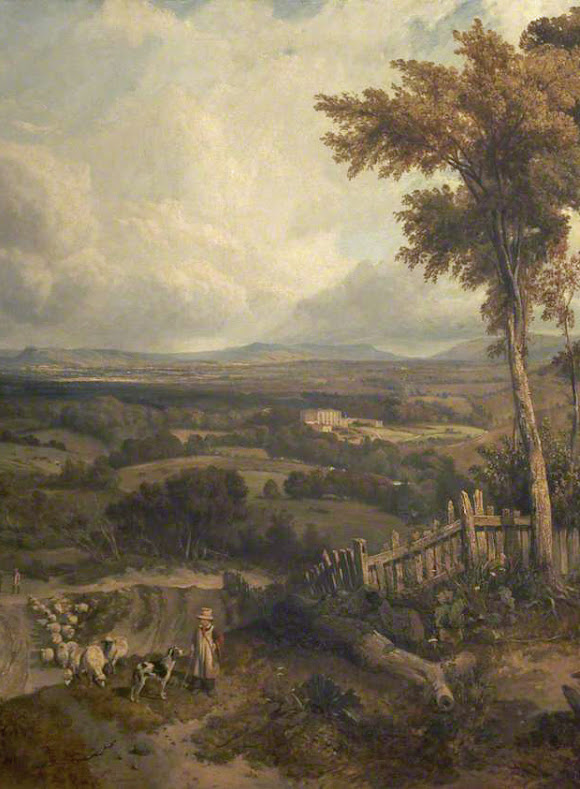 |
| 1829 A View near Devizes, with Stoke Park, Erlestoke, in the Middle Distance detail |
 |
| 1829 On the Rhine, near Cologne oil on canvas 106.7 x 87.7 cm V&A, London |
 |
| 1829 The Old Bridge at Lyons watercolour on paper 30 x 30 cm Royal Watercolour Society, London |
 |
| 1830 Mount St Michael, Cornwall oil on canvas 153.2 x 244 cm National Gallery of Victoria, Melbourne |
 |
| 1830 Mount St Michael, Cornwall detail |
 |
| 1830 Seascape oil on canvas 73 x 101.7 cm Sudley House, Liverpool, UK |
 |
| c1830s A man playing a musical instrument pencil and watercolour on light blue wove paper 15.2 x 7.3 cm Royal Academy of Arts, London |
 |
| c1830s A man playing a musical instrument pencil and watercolour on light blue wove paper 15.4 x 7.5 cm Royal Academy of Arts, London |
 |
| after 1831 The Opening of London Bridge by William IV, 1 August 1831 oil on canvas 71 x 91 cm Guildhall art Gallery, London |
 |
| 1831-32 The Opening of New London Bridge, August 1831 oil on canvas 152.1 x 244.8 cm Royal Collection Trust |
 |
| after 1831 The Opening of London Bridge by William IV, 1 August 1831 engraving |
 |
| 1832 Richmond (attributed to) pen and brown ink, over graphite, on blue wove paper 21.8 x 29 cm Art Institute of Chicago, IL |
 |
| c1832 Delphi watercolour over pencil with gouache, gum arabic and scratching out 29.7 x 22.8 cm National Gallery of Victoria, Melbourne |
 |
| 1833 Lord Nelson over the Combined French and Spanish Fleets, October 21, 1805 oil on panel 38.7 x 80.3 cm Tate, London |
 |
| 1833 Lord Nelson over the Combined French and Spanish Fleets, October 21, 1805 detail |
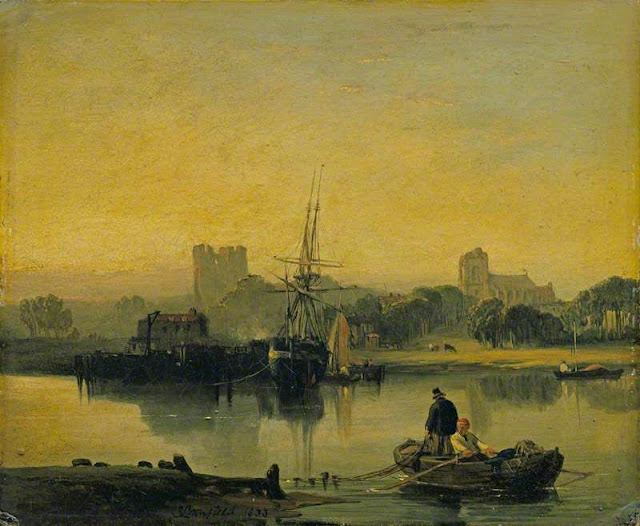 |
| 1833 Orford oil on millboard 25 x 30.5 cm The Wallace Collection, London |
 |
| 1834 Eu, looking towards Tréport graphite, watercolour and gouache on paper 19.2 x 27.9 cm Tate, London |
 |
| 1836 The Battle of Trafalgar oil on canvas (details not found) |
 |
| 1836 The Battle of Trafalgar detail |
 |
| 1836 The Canal of the Guidecca, and the Church of the Gesuati, Venice oil on canvas 61 x 90.2 cm Tate, London |
 |
| 1836 The Canal of the Guidecca, and the Church of the Gesuati, Venice detail |
 |
| 1836-37 Beilstein on the Moselle oil on canvas 114.3 x 163.7 cm The Wallace Collection, London |
 |
| c1836 A seated man, possibly for 'The Battle of Trafalgar' pencil, black and white chalk on grey wove paper 18.6 x 15.9 cm Royal Academy of Arts, London |
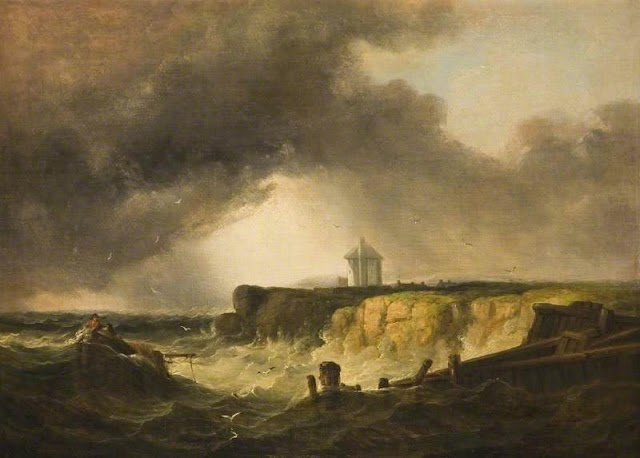 |
| 1837 Fishing Boats off the Coast oil on canvas 41 x 51 cm Birmingham Museums Trust, UK |
 |
| 1837 On the Scheldt near Leiskenshoeck: a Squally Day oil on canvas 96.6 x 130.2 cm Royal Academy of Arts, London |
 |
| 1837 On the Scheldt near Leiskenshoeck: a Squally Day detail |
 |
| 1838 Namur, Junction of the Meuse and Sambre watercolour |
 |
| 1838 Sands near Boulogne oil on canvas 71.1 x 110.5 cm © V&A, London |
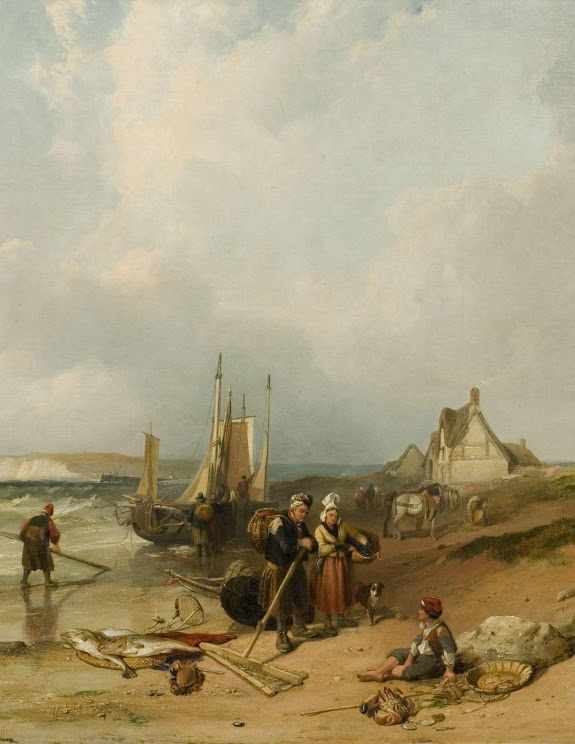 |
| 1838 Sands near Boulogne detail |
 |
| 1838 The 'Chasse Mareé' off the Gull Stream Light, the Downs in the Distance oil on canvas 98 x 129 cm Sunderland Museum & Winter Gardens, UK |
 |
| 1839 Distant View of Vesuvius, by Sunset watercolour and gouache on paper 12.8 x 17.7 cm Tate, London |
 |
| 1839 The Smoke of the Volcano pastel on paper 12.8 x 17.8 cm Tate, London |
 |
| 1839 Vesuvius in Eruption watercolour and gouache on paper 12.8 x 17.7 cm Tate, London |
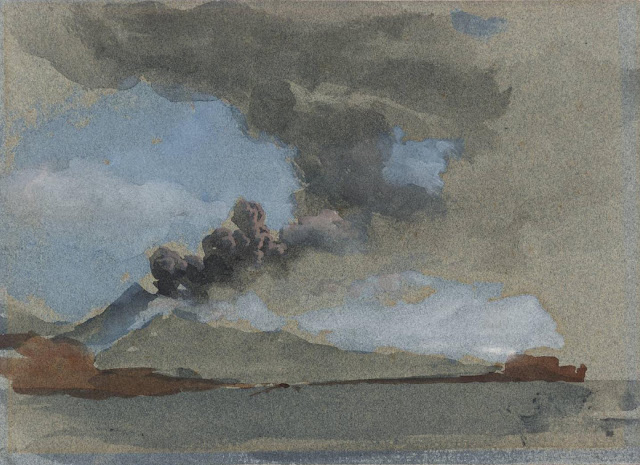 |
| 1839 Vesuvius in Eruption watercolour and gouache on paper 12.8 x 17.8 cm Tate, London |